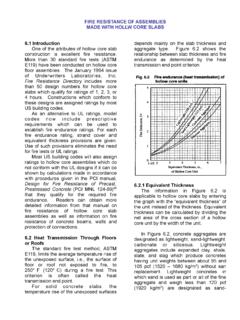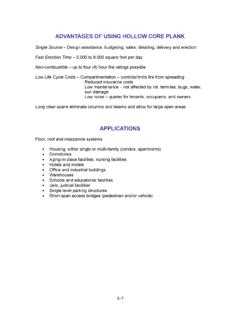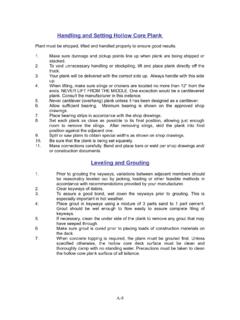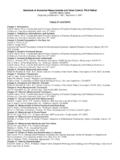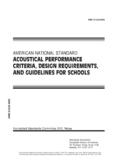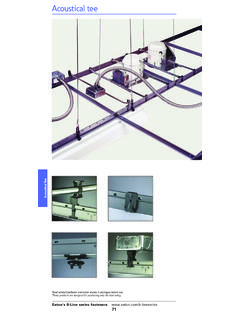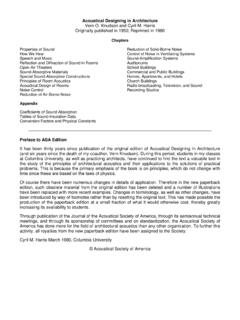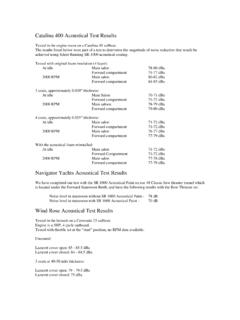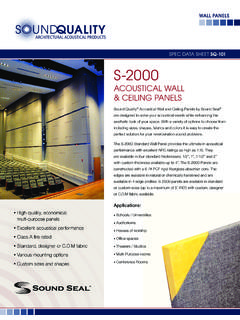Transcription of ACOUSTICAL PROPERTIES OF - Mid South Prestress
1 ACOUSTICAL PROPERTIES OF HOLLOW CORE FLOOR SLABS GlossaryAirborne Sound sound that reaches the point of interest by propagation through Level the ambient sound pressure level existing in a (dB) a logarithmic unit of measure of sound pressure or sound power. Zero on the decibel scale corresponds to a standardized references pressure (20 Pa) or sound power (10-12 watt).Flanking Transmission transmission of sound by indirect paths other than through the primary (Hz) the number of complete vibration cycles per Insulation Class (IIC) a single figure rating of the overall impact sound insulation merits of floor-ceiling assemblies in terms of a reference contour (ASTM E989).Impact Noise the sound produced by one object striking unwanted Criteria (NC) a series of curves, used as design goals to specify satisfactory background sound levels as they relate to particular use Reduction (NR) the difference in decibels between the space-time average sound pressure levels produced in two enclosed spaces by one or more sound sources in one of Reduction Coefficient (NRC) the arithmetic average of the sound absorption coefficients at 250, 500, 1000 and 2000 Hz expressed to the nearest multiple of (ASTM C423).
2 Reverberation the persistence of sound in an enclosed or partially enclosed space after the source of sound has Criteria (RC) Curves a revision of the NC curves based on empirical studies of background the unit of measure of sound absorption (ASTM C423).Sound Absorption Coefficient ( ) the fraction of randomly incident sound energy absorbed or otherwise not reflected off a surface (ASTM C423).Sound Pressure Level (SPL) ten times the common logarithm of the ratio of the square of the sound pressure to the square of the standard reference pressure of 20 Pa. Commonly measured with a sound level meter and microphone, this quantity is expressed in Transmission Class (STC) the single number rating system used to give a preliminary estimate of the sound insulation PROPERTIES of a partition system.
3 This rating is derived from measured values of transmission loss (ASTM E413).Sound Transmission Loss (TL) ten times the common logarithm of the ratio, expressed in decibels, of the airborne sound power incident on the partition that is transmitted by the partition and radiated on the other side (ASTM E90).Structureborne Sound sound that reaches the point of interest over at least part of its path by vibration of a solid GeneralThe basic purpose of architectural acoustics is to provide a satisfactory environment in which desired sounds are G-2clearly heard by the intended listeners and unwanted sounds (noise) are isolated or most conditions, the architect/ engineer can determine the ACOUSTICAL needs of the space and then design the building to satisfy those needs. Good ACOUSTICAL design utilizes both absorptive and reflective surfaces, sound barriers and vibration isolators.
4 Some surfaces must reflect sound so that the loudness will be adequate in all areas where listeners are located. Other surfaces absorb sound to avoid echoes, sound distortion and long reverberation times. Sound is isolated from rooms where it is not wanted by selected wall and floor-ceiling constructions. Vibration generated by mechanical equipment must be isolated from the structural from of the ACOUSTICAL situations can be described in terms of (1) sound source, (2) sound transmission path, and (3) sound receiver. Sometimes the source strength and path can be controlled and the receiver made more attentive by removing distraction or made more tolerant of disturbance. ACOUSTICAL design must include consideration of these three in (150 mm) hollow core slabsAssembly 1 with carpet and padAssembly 1 with in (13 mm) wood block flooring adhered directlyAssembly 1 with in (13 mm) wood block flooring adhered to in (13 mm) sound-deadening board underlayment adhered to concreteAssembly 1 with in (19 mm) gypsum concreteAssembly 1 with in (19 mm) gypsum concrete on in (13 mm) sound-deadening board underlayment adhered to concreteAssembly 1 with carpet and pad on 3/4 in (19 mm) gypsum concrete on in (13 mm) sound-deadening board underlayment adhered to concrete8 in (200 mm) hollow core slabsAssembly 8 with carpet and padAssembly 8 with in (13 mm) wood block flooring adhered directlyAssembly 8 with in (13 mm) wood block flooring adhered to in (13 mm) sound-deadening board underlayment adhered to concreteAssembly 8 with in (13 mm)
5 Wood block flooring adhered to in (13 mm) plywood adhered to 7/16 in (11 mm) sound-deadening board underlayment adhered to concreteAssembly 8 with 5/16 in (8 mm) wood block flooring adhered to in (6 mm) polystyrene underlayment adhered to concreteAssembly 8 with vinyl tile adhered to in (13 mm) plywood adhered t o 7/16 in (11 mm) sound-deadening board underlayment adhered to concreteAssembly 8 with vinyl tile adhered to in (6 mm) inorganic felt supported cushion underlayment adhered to concreteAssembly 8 with vinyl tile adhered to in (3 mm) polyethylene foam underlayment adhered to concreteAssembly 8 with 1 in (38 mm) concrete toping with carpet and padAssembly 8 with 1 in (38 mm) concrete topping with vinyl tile adhered to concreteAssembly 8 with 1 in (38 mm) concrete topping with vinyl tile adhered to 3/8 in (9 mm) plywood adhered to in (13 mm) sound-deadening board adhered to concreteAssembly 8 with 1 in (38 mm) concrete with in (13 mm) wood block flooring adhered to in (13 mm) sound-deadening board adhered to concreteAssembly 8 with 1 in (38 mm) concrete with 5/16 in (8 mm) wood block flooring adhered to foam backing adhered to concreteAssembly 8 with 3/4 in (19 mm) gypsum concrete with 5/16 in (8 mm) wood block flooring adhered to foam backing adhered to concreteAssembly 11 with ACOUSTICAL ceilingAssembly 8 with quarry tile, 1 in (32 mm) reinforced mortar bed with in (10 mm nylon and carbon black spinerette mattingAssembly 24 with suspended 5/8 in (16 mm) gypsum board ceiling with 3 in (90 mm) insulation484848495050505050515252505050 5050505251515059606123694849415072287347 545551515158764455535453615462)
